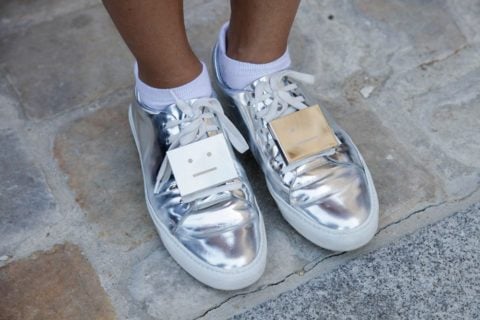You can’t wear flats at Cannes (and why that majorly sucks for women)

If you’re at Cannes (congratulations), and you’re wearing flats (good choice), you will allegedly be turned away from the red carpet.
The news materialized via Screen Daily, who reported that multiple women were turned away from the “Carol” red carpet for wearing inappropriate footwear, including women in their 50s and women with disabilities, who were donning rhinestone flats. In turn, the festival director stepped up to squash the claims, saying they were “unfounded.”
“Rules have not changed throughout the years (tuxedo, formal dress for gala screenings) and there is no specific mention about the height of women’s heels as well as for men’s,” a Cannes spokesperson told the BBC.
However, Asif Kapadia (director of the documentary, “Amy”) tweeted about his own wife being nearly turned away for wearing flats, while Valeria Richter told the Telegraph she’d been reprimanded about her footwear, despite her missing a toe and part of her foot.
Understandably, this bodes badly for Cannes, especially since the festival has already come under scrutiny for gender imbalance—a wrong they’ve been trying to right, despite having only two female directors in competition. And while the heel/flat debacle is still in the he said/she said stage of existence, the fact that even one person (allegedly) was questioned on the height of their footwear indicates the presence of some serious sexism.
“Everyone should wear flats, to be honest, at the best of times,” Emily Blunt said at a press conference for “Scario,” referring to the news as “disappointing.” “You kind of think that there’s these new waves of equality.”
And then you realize there isn’t.
Regardless of whether or not heel height is the problem, the fact that Cannes — or any other festival — is basing their dress code on gender convention is what’s most upsetting. The official dress code states the men must wear tuxedos with bow ties and black shoes, while women are expected to wear dresses with heels — but why? Why, in 2015, when we’re preaching the importance of equality and teaching that we’re more than the anatomy we happened to have been born with, are we insisting professional adults abide by a dress code that goes against both of those things?
In the same panel as Blunt, director Denis Villeneuve joked that he and Benicio Del Toro (“Scario’s” other co-star) should take to the red carpet in heels as protest, which would be a bold and justified move because Cannes’ dress code is just as damaging to men as it is to women. To say that men and women must dress to accommodate gender roles or risk being turned away from a major cinematic event (effectively hurting their careers) sends the message that there is only one way for men and women to dress in general. And considering movies have provided the prime platform for social discussion and progress, instituting a limiting dress code goes against everything the arts stands for. Isn’t the point of the arts to challenge and rebel?
Ultimately, what’s happening at Cannes right now—whether it be its dress code, or its call for a specific heel height—serves as a reminder that even in so-called “safe places” (see: an industry based on the freedom of self-expression), there’s a long way to go in terms of inclusion. We have progressed in certain ways, yes, but in terms of gender-based thinking, even the film industry needs to catch up. We’re more than tuxedos, bowties, gowns, and high heels. The clothes shouldn’t make the (wo)man.







